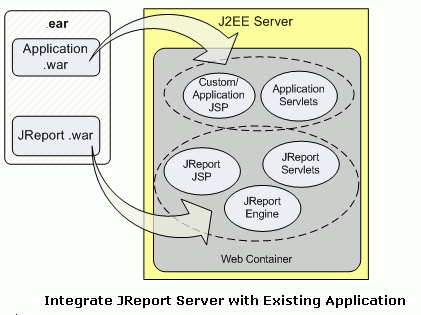


JReport Server can be integrated into an existing web application. Put the application's JSP files and servlets together with the JReport JSP files and servlets, along with the JReport Server library files. Read more about the details on how to do this in the Integrating JReport Server with a Java Application Server chapter in the JReport Server User's Guide.
After JReport Server is installed along with the existing application, the application can be extended by writing new code that uses the JReport Server API library.
It is when JReport Server is used as part of a larger web application that it's other identity begins to show. JReport Server API comes into view. JReport Server contains is a large set of classes with methods that can be used by any Java program. This set of classes and methods is the JReport Java API.
An existing application can integrate with JReport Server web pages in a simple fashion by adding links from the existing application to the JReport Server JSP pages.
This provides the JReport Server web pages with the look and feel that is native to JReport Server.
Because the JReport Server web application is implemented as JSP pages, these can be edited to change the look and feel while not changing the functionality.
An existing application can be extended to access JReport Server functionality by adding Java code to access the Report Server classes and methods that are defined in the Java API. An existing application can have complete control over the look and feel of web pages while providing access to running and scheduling reports and viewing results.
Many of the JSP pages in JReport Server could be copied to the customer's application, modified, ignored or removed and have web interactions with users provided by an extended existing application, using Java calls to request report functionality.